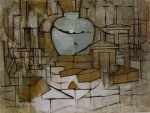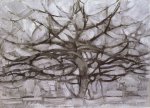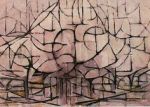Fascinating Rythms
April 29, 2019 § Leave a comment
 Piet Mondrian, 1872-1944
Piet Mondrian, 1872-1944
“… All you need now is to stand at the window and let your rhythmical sense open and shut, open and shut, boldly and freely, until one thing melts in another, until the taxis are dancing with the daffodils, until a whole has been made from all these separate fragments.” -Virginia Woolf, A Letter to a Young Poet
Children of a certain age are strangely masterful in wielding a brush. They don’t have to be told what to do, or how to do it. Mark-making is a deep, instinctual, and self-sufficient pleasure as old as the human race. Some manage to hold on to the natural feeling for rhythm, movement and relationship in art making as they leave childhood, but too often it becomes buried in the adult whose only model for form-making is the smooth, indiscriminately detailed facture of photography. Re-awakening these dynamic instincts should be as important a goal to the student of painting as learning to see and mix color.
The experiments of artists in the early 20th century are instructive for unpacking this business of rhythm and movement in painting. Abstract forces exist in all painting, and in any view of nature, but they often are disguised, especially to the novice, by the dominance of illusionistic concerns. In the early decades of the 20th century, just as the theories of Einstein began to undo and reshape traditional notions of time and space, Modern art movements such as Cubism, Futurism, De Stjil, and Constructivism began to reorient the focus of painting away from the outward appearance of solid matter to the internal dynamics of pictorial structure. The fractured spaces of George Braque and Picasso, and the reductive verticals, horizontals and diagonals of Theo Van Doesburg and Piet Mondrian began to speak of an energetic reality behind appearances.
Jack Boul, one of my teachers in grad school, made a comment that I think brilliantly frames a fundamental problem of painting. He said, “We sense the structure in early Mondrian. His line first represents a vertical, then a division of the picture space, then a tree. Most people just paint the tree.”
If the Renaissance, and the centuries of pictorial traditions it fostered, were based on the assumption of a solid world composed of discreet entities in a measurable space, the new spirit in painting was informed by the scientific revelation that matter is not solid at all – it’s energy. E=mc2. Painting’s formal language becomes a corollary to this new vision – the structured, dynamic rhythms of the physical universe played out on the artist’s canvas.
The Beauty of Shapes
September 24, 2011 § Leave a comment
“We look up and see a coloured shape in front of us and we say – there is a chair. But what we have seen is the mere coloured shape. Perhaps an artist might not have jumped to the notion of a chair. He might have stopped at the mere contemplation of a beautiful color and a beautiful shape…” -Alfred North Whitehead
“Remember that a picture, before being a battle horse, a nude woman, or some anecdote, is essentially a plane surface covered with colors assembled in a certain order.” -Maurice Denis (1890)
How often we forget the simple truth of Maurice Denis’ statement as we peer into our three-dimensional world and try to “make” a tree, a face, a figure, or a teacup on our canvas. Annie Dillard’s essay on seeing, from a previous post on this blog, reminds us of just how far we’ve come from the infantile state of innocence when visual sensation was just “color-patches unencumbered by meaning.” The struggle to regain this innocent vision of color and shape is a large part of our “training” as artists. We want to be able to see our sensations, not just the things those sensations add up to, because this kind of seeing is what allows us to form questions that we can take to the palette. What is that hue? What is its tonal value? What is it’s degree of saturation or intensity? These three questions are the Holy Trinity of color mixing. (There’s a fourth, but we’ll save it for another post.)
But mixing color is only one piece of the puzzle. The color has to have a boundary or shape. This is the meeting place of drawing and painting. Stripped of the third dimension, the world’s forms and spaces precipitate two-dimensional shapes. Out of this distilled essence painters compose their paintings. Here are some painters who remind us of the beauty of shapes, all kinds of shapes. That’s what paintings are made of.


































































































































